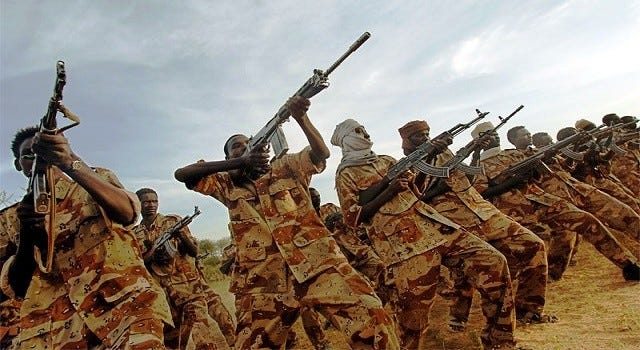Mercenaries and Manpower
Overshadowed by stories of dwindling munitions stocks and limited production capacity, the Ukraine War has revealed another shortfall facing modern armies: manpower. Both Russia and Ukraine have faced recruitment difficulties, foreshadowing problems that other countries may encounter in the near future. The post-Cold War shift from large mass-mobilization armies to high-end boutique forces has followed a broader economic trend of meeting high labor costs with investments in technology, yet this is proving inadequate even for military operations well short of full-scale war.
Reversing this is not as simple a matter as changing recruitment policies. Industrialized nations face a demographic shortfall of young men, a problem which will only grow worse for at least the next couple decades. National leaders are moreover increasingly reluctant to risk the political backlash from casualties, to say nothing of the economic disruption that comes with pulling a large chunk of labor out of the economy. Nor is this only a problem for industrialized nations: birthrates are falling around the world, with the Middle East and Latin America approaching replacement-level.
Of these two major problems facing modern militaries—a shortage of weapons and of manpower—the first is more readily solvable. Even where one country’s stocks are insufficient, allies can make good the gap, as has been happening on both sides in Ukraine. This intervention can sometimes be decisive: Turkish weapons deliveries allowed the Libyan government to stop Haftar’s advance in 2018, and the UAE’s provision of drones quickly turned the Tigray War around in 2022.
Yet arms alone are not always sufficient. The evolution of advanced weapons and countermeasures has driven the cost of both up, and there are tight bottlenecks and long lead-times to production. Without sufficient manpower or mass firepower, it is possible to end up in a deadlock—Ukraine is the most obvious example, and Libya has remained a frozen conflict. Moreover, this affects not just planning for large-scale conflict, but for any commitment that has the potential to expand in scope. Manpower, then, remains a fundamental problem.
Outsourcing Manpower
These problems are demonstrated in an extreme form by the United Arab Emirates. A small but extremely wealthy country, it has geopolitical ambitions far in excess of what its population alone could justify. Its total armed forces numbers only 65,000, of which fewer than 20,000 are said to be deployable. These have been active in Yemen, where from 2015 to 2019 the UAE maintained 15,000 troops. Uniformed soldiers were involved mostly in training and support roles, however: most of the fighting was done by tens of thousands of mercenaries reportedly brought into the conflict, mostly from Africa and Latin America.
Private military contractors have been increasingly used in the past several decades, but this was a step beyond their traditional role in combat zones, which has mostly been in support—training local forces, technical support, security, logistics, and occasional SOF roles. What distinguishes the UAE in Yemen is that a power deployed third-country mercenaries alongside its own regular troops—a rarity in the 21st century.
The demand for manpower may see more mercenaries in frontline roles, augmenting national forces during major deployments or even forming the whole of an expeditionary corps for politically sensitive operations. Russia’s Wagner Group is something of a template for this: although more of an organ of the state than a true PMC, used to deploy Russian ex-servicemen without official involvement, it has been active throughout Africa and the Middle East.
The Global Market
Before militaries could start using mercenaries at any scale, there would need to be a much more robust market for their services. The example of 16th and 17th-century Europe, where mercenaries formed the greater part of most armies, gives us some idea of what that might look like. Sovereigns developed relationships with reliable contractor-colonels, who in turn relied on a network of recruiters who could quickly raise bodies of troops. The contractor was responsible for training and leading those soldiers, but they fell under the command of the sovereign’s field army. Mercenaries of that era were not the faithless freebooters of popular stereotype, and it was rare for a contractor to burn his relationship with an established client to fight for his enemy, although that did happen when the employer failed to live up to his side of the bargain.1
The broader market in military services was not so exclusive. Individual soldiers might fight for different colonels, while arms manufacturers and shippers often sold to the highest bidder. This depended on a large number of small neutral states and free cities which could serve as network nodes and intermediaries in wartime—Genoa, for instance, served as a provisions depot and recruiting ground for both sides during the War of the Spanish Succession (1701-14).

21st-century markets cannot be quite so freewheeling. The world is far from multipolar, breathless commentary notwithstanding, and America’s ability to restrict worldwide financial flows means that very few entities would be willing to source mercenaries from or provide them to sanctioned countries. That still leaves a broad class of other conflicts, however, where the US is too undecided, indifferent, or distracted to throw its weight around. Libya, for instance, saw Turkey and Italy provide support to the national government, while Egypt, the UAE, and France backed General Haftar.
A secondary consideration is the ambiguous legal status of PMCs in combat roles. Mercenaries are not protected under the Geneva Conventions, which define mercenaries as individuals who are neither nationals nor members of the armed forces of any party in a conflict. Countries may seek to get around this by recruiting entire units, trained and led by their own commanders, into the national military (as opposed to recruiting individuals into a foreign legion, as Ukraine has done)—exactly what was done in early modern Europe.
The Structure of the Marketplace
As things stand, small hydrocarbon-rich countries such as the UAE and Qatar stand to play an important role in any future mercenary marketplace, similar to what Genoa, Amsterdam, and the small states of the Holy Roman Empire once did. Their wealth gives them the capital to make the initial investments and a certain degree of political independence, while the Emiratis in particular already have a network of contacts that would allow them to raise large numbers of fighters.
Frontline combat troops are not the only manpower shortages revealed by the Ukraine War. As the fighting has gone on, both sides have suffered from losses of experienced staff officers and lower-level commanders. Even a full-scale mobilization cannot rectify these losses quickly, creating indefinite shortfalls in their ability to mount complex operations. This is where mercenaries could have a more immediate effect, filling out battalion, brigade, or theater staffs—the UAE has commissioned retired US officers into its armed forces for precisely this purpose.
Since these are not necessarily combat roles, other countries could hire contractors as civilian “advisors”. Already in 1995, the contractor MPRI assisted the Croatians in planning Operation Storm during their war of independence. This was done with the blessing—if not active support—of the US government, but there is widening commercial (as opposed to diplomatic) demand for these services, especially as new weapons make command-and-control more complex.
This is not to say that the market for mercenaries is quite on the verge of taking off. Beyond the legal and diplomatic concerns, most countries are too conscious of their public image to risk embracing something which still carries a sordid reputation. It will likely be combatants in dire straits that first openly employ them as a convenient expedient for replacing battlefield losses. PMCs could initially be contracted to reconstitute shattered units, rolling regular soldiers into their own structure, or simply to relieve exhausted units on the line. The other major avenue is as proxy forces: the sheer cost of full-scale war increases the risk of limited wars in which they could be employed, although this would likely be accompanied by denials of any official involvement.
As much uncertainty as there is about the role of PMCs on future battlefields, they are likely to continue expanding their activities closer to the front line. The demographic issues facing countries today are simply too severe to be addressed by a simple policy solution, and, barring a massive cultural shift, will remain a problem for the next several generations. Whatever the wisdom or legality of reintegrating mercenaries into national armies, the ruthless competition of warfare is likely to dissolve any objections in the long run.
Thank you for reading the Bazaar of War. Most articles are free for all to read, but a subscription option is available to all who wish to support. Subscribers receive the critical edition of the classic The Art of War in Italy: 1494-1529 and will have exclusive access to occasional pieces.
You can also support by purchasing Saladin the Strategist in paperback or Kindle format.
For an outstanding discussion of mercenaries in this period, both in a combat and service-support role, see The Business of War.


I suspect that it would be hard to come by reliable data but it would be an interesting aside to this conversation to note the number of immigrants enlisting in Western militaries for economic reasons and as a path to citizenship. You already noted the demographic shift in industrialized and now post-industrial societies - increasing the collective pressure for the use of 'robots' of various kinds for high risk roles.
I have this feeling that the next few decades are gonna get real messy and the demand for mercenaries, if not skyrocket, will increase by a lot.
I expect populations from the Middle East, Africa, South and Central Asia, and maybe Southeast Asia to be potential recruits by the west (North America, Europe, Russia, Australia).